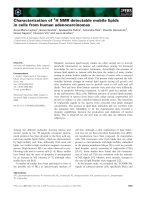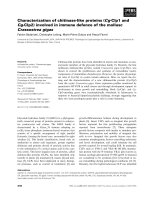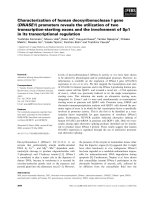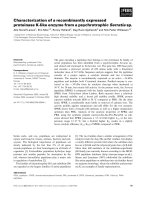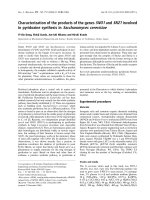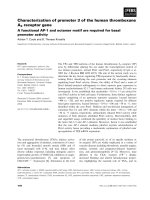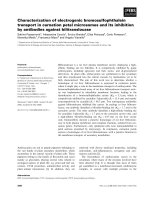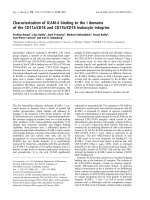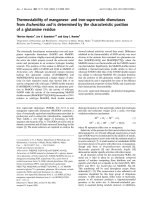Tài liệu Báo cáo Y học: Characterization of a novel silkworm (Bombyx mori ) phenol UDP-glucosyltransferase potx
Bạn đang xem bản rút gọn của tài liệu. Xem và tải ngay bản đầy đủ của tài liệu tại đây (344.35 KB, 7 trang )
Characterization of a novel silkworm (
Bombyx mori
) phenol
UDP-glucosyltransferase
Teresa Luque
1
, Kazuhiro Okano
2
and David R. O’Reilly
1
1
Department of Biology, Imperial College of Science, Technology and Medicine, London SW7 2AZ, UK;
2
Laboratory of Molecular Entomology and Baculovirology, Riken, Wako, Japan
Sugar conjugation is a major pathway for the inactivation
and excretion of both endogenous and exogenous com-
pounds. We report here the molecular cloning and f unc-
tional characterization of a phenol UDP-glucosyltransferase
(UGT) from the silkworm, Bombyx mori,whichwasnamed
BmUGT1. The complete cDNA clone is 1.6 kb, and the
gene is expressed in several tissues of fifth-instar larvae,
including fat body, midgut, integument, t estis, silk gland a nd
haemocytes. The pr edicted protein comprises 520 amino
acids and has 30% overall amino-acid identity with other
members of t he UGT family. T he most conserved r egion of
the protein is the C-terminal half, which has been implicated
in binding the UDP-sugar. BmUGT1 was expressed in insect
cells using the baculovirus expression system, and a range of
compounds belonging to diverse chemical groups were
assessed as potential substrates for the enzyme. The
expressed enzyme had a wide substrate specificity, showing
activity with flavonoids, coumarins, terpenoids and simple
phenols. These results s upport a role for t he enzyme in
detoxication processes, such as minimizing the harmful
effects of ingested plant alle lochemicals. This work repre-
sents the first instance where an insect ugt gene has been
associated w ith a specific enz yme activity.
Keywords: Bombyx mori; detoxication; insect; UDP-
glycosyltransferase.
The UDP-glycosyltransferases ( UGTs) are a superfamily of
enzymes that p lay a central role in the detoxication and
elimination of a wide range of endogenous and exogenous
compounds. Members o f t his s uperfamily are present in
animals, plants, bacteria and viruses, suggesting an ancient
origin (reviewed in [1–3]). These enzymes catalyze the
addition of the glycosyl group from a nucleotide s ugar to a
variety of small hydrophobic m olecules (aglycones), result-
ing in m ore hydrophilic compoun ds that are e fficiently
excreted. The UDP-sugar may be UDP-glucuronic a cid,
UDP-galactose, UDP-glucose, or UDP-xylose.
The best-characterized UGTs a re the m ammalian UDP-
glucuronosyltransferases, which use UDP-glucuronic acid
as sugar donor. These enzymes catalyze the glucuronidation
of numerous endogenous substrates, such as bile acids,
bilirubin, steroids, thyroxine and fat-soluble vitamins, and a
great number of exogenous compounds, inclu ding several
drugs [3]. These conjugation r eactions are highly important
physiologically, as reflected by the association of s everal
serious pathologies with altered UGT function [1,4,5].
UDP-glucuronosyltransferases are located in the lumen
of the endoplasmic reticulu m and are membrane-b ound.
The putative transmembrane domain is l ocated near the
C-terminus of the protein and only a small portion of the
protein is found in the cytosol [3].
UGTs r elated to those found in vertebrates have also
been found in ins ects and are likely to play e qually
important roles. However, only limited information is
available on UDP-glycosyltransferase activity in insects.
Insect UGT enzymes typically use UDP-glucose rather than
UDP-glucuronic acid a s sugar donor [6–8]. Similarly to the
vertebrates, glucosidation in insects is believed to involve
both endogenous and exogenous substrates. Thus, the
UGTs play an important role in detoxication of plant
allelochemicals encountered by many insects in their diet [7].
Similarly, UGT-catalyzed biotransfo rmation of x enobiotics
has been implicated in some cases of insecticide resistance
[9]. In addition, glu cosidation in i nsects is known to be
involved in cuticle formation, pigmentation and olfaction
[10–12]. In Drosophila, glucose conjugation o f t he endoge-
nous compound, xanthurenic acid, and several exogenous
compounds, including 4-nitrophenol, 1-naphthol and
2-naphthol has been reported [ 8,13]. I n o ther insect species,
such as Manduca sexta, t he presence of multiple enzyme
forms has also been suggested [7]. Recently, the expression
of some Drosophila ugt genes in the antennae has been
reported [12]. Similarly, an expressed sequence tag (EST)
corresponding to a UGT homologue has been described
from a m ale M. se xta antennae cDNA library [14]. I n all of
these cases, the specificity o f the enzyme encoded by the
gene identified is unknown. To date, hardly any information
is available on glucosidation in the silkworm, Bombyx mori.
This is an economically important s pecies, in particular
because of i ts propagation on a large scale a nd utilization
for silk production.
Here, we describe the isolation and characterization of a
novel B. mori UDP-glucosyltransferase gene, Bmugt1,and
analysis of the activity of the enzyme towards a range of
Correspondence to D. R. O’Reilly, Department of Biology, Imperial
College of S cience, Technology and Med icine, Imperial College Road,
London SW7 2AZ, UK. F ax: + 44 20 7 5842056,
Tel.: + 44 20 75945376, E-mail: do
Abbreviations:UGT,UDP-glycosyltransferase;EST,expressed
sequence tag; EGT, ecdysteroid UDP-glucosyltransferase.
Enzyme: U DP-glycosyltransferase (EC 2.4.1 ).
(Received 10 September 2001, revised 28 November 2001, accepted 29
November 200 1)
Eur. J. Biochem. 269, 819–825 (2002) Ó FEBS 2002
structurally different compounds. We report that t he
enzyme can conjugate a wide range o f substrates including
flavonoids, coumarins a nd other phenolic compounds. T his
is the first time a specific activity has been ascribed to any
insect ugt gene.
MATERIALS AND METHODS
Identification and sequence analysis of
Bmugt1
The B. mori ugt1 gene was first identified in the course of an
EST s equencing project. A wing disc cDNA library derived
from fifth instar B. mori C108 larvae was kindly provided
by Dr Kawasaki (University of Utsunomiya, Japan). A
total of 1000 clones were s elected at random and s equenced
from the 5¢ end by automatic sequencing (ABI377XL DNA
sequencer; the EST datab ase based on these sequences is
available on the internet at .jp/
silkbase/). Homology searches revealed that the EST
sequence wdS20142 showed low b ut significant similarity
to baculovirus ecdysteroid UGTs [15]. This clone was
sequenced in its e ntirety using a L i-Cor m odel 4000 DNA
sequencer and
BASE IMAGIR
software. The clone was found
to include the complete c DNA. T he nucleotide sequence o f
the Bmugt1 gene has been deposited in the GenBank
database under the accession number AF324465.
Analysis of gene expression
B. mori (Shuko · Ryuhak u) eggs were obtained from
Katakura Kogyo (Matsumoto, Japan), and the larvae were
reared on an artificial diet as d escribed previously [16].
Tissues were dissected f rom 5-day-old fi fth-instar lar vae,
washed twice in NaCl/P
i
, snap-frozen in liquid nitrogen, and
stored at )80 °C. Haemocytes were isolated from haemo-
lymph by centrifugation at 750 g for 5 min at 4 °Cand
washed twice in N aCl/P
i
before freezing. Total cellular
RNA from different tissues (fat body, midgut, integument,
testis, silk gland and haemocytes) was isolated by the
guanidinium thiocyanate method [17]. Integument samples
may have contained small amounts of muscle and tracheal
tissue also. Bmugt1 expression was s tudied by RT-PCR
using the internal oligo nucleotides 5¢-GATCGCCTTGT
AATTCTG-3¢ (position 798–781 from t he ATG s tart codon)
for cDNA synthesis and 5¢-CCGTGATTGTTGAGTG
GATG-3¢ and 5¢-AAGCAACTCCAGTAGACACG-3¢
(position 386–405 and 769–750, respectively, from the
ATG s tart codon) for PCR amplification. The P CR
conditions were an initial denaturation step of 1 min 30 s
at 94 °C a nd then 35 cycles of 45 s a t 94 °C, 45 s a t 5 5 °C,
and 45 s at 72 °C.
Construction and characterization of a recombinant
baculovirus expressing
Bmugt1
The Bmugt1 cDNA was cloned into the single SmaIsiteof
the pSynXIV VI
+
X3 transfer vector [18]. The presence of
the correct insert was confirmed by s equence analysis. This
plasmid DNA was cotransfected with Bsu36I-digested
vEGTSyngal+ viral DNA [19] into Spodoptera frugiperda
SF21 insect cells [20] by calcium phosphate coprecipitation
[21]. Recombinant viruses were isolated from the transfec-
tion supernatant by plaque purification. Occlusion-positive
plaques, representing recombinant viruses, were picked and
plaque purified. S ingle isolated r ecombinant viruses w ere
amplified to obtain high-titre virus stocks. V irus titres were
determined by plaque assays [22]. Recombinant viral DNA
was purified and characterized by restriction mapping
following standard procedures [22]. The r ecombinant virus,
vSynBmUGT1, containing the Bm u gt1 gene, was chosen
for expression analyses.
Expression of recombinant protein
Expression of recom binant p rotein was c haracterized by
metabolic labelling of infected cells at various times
postinfection (p.i.) [22]. Cells infected with vSynBmUGT1
or parental viral DNA or mock-infected cells were treated in
parallel. Briefly, SF21 cells we re infected at a multiplic ity of
infection of 20 plaque-forming units per cell following
standard procedures. Two hours before the appropriate
time point, the medium was removed and replaced by
methionine-deficient medium. After 1 h, the medium was
removed a nd replaced with methionine-deficient medium
containing 25 lCi trans-
35
S-label (1175 CiÆmmol
)1
;ICN
Biomedicals, Inc.) and incubated at room temperature for
1 h. At the time point, cells were rinsed three times with
NaCl/P
i
, pH 6.2. Cells were lysed by incubation on ice for
30minin50lL cell l ysis buffer (1% Nonidet P 40, 150 m
M
NaCl, 50 m
M
Tris/HCl, pH 8), and stored at )80 °C.
Protease inhibitors were added t o t he cell lysis buffer a t the
following concentrations: pepstatin, 1 lgÆmL
)1
; leupeptin,
1 lgÆmL
)1
; aprotinin, 1 lgÆmL
)1
; phenylmethanesulfonyl
fluoride, 100 lgÆmL
)1
;E64,0.35 lgÆmL
)1
. Selected 48 h p.i.
samples were exposed to 5 lgÆmL
)1
tunicamycin for 12 h
before harvesting (i.e. from 36 to 48 h p.i) and then
processed in parallel with the rest of the samples. The
protein samples, each representin g 2 · 10
5
cells, were
separated by SDS/PAGE (10% gel) [23]. The gels were
then stained with Coomassie blue, dried, and exposed to
X-ray film.
Activity assays
Trichoplusia ni TN368 [24] cells we re used for assay o f
BmUGT1 activity, because SF21 cells were found to express
low levels of endogenous UGT a ctivity t owards several of
the substrates t ested (data not shown). Cells were infected
with vSynBm UGT1 o r parental virus, vEGTSyngal+, at a
multiplicity of infection of 20 a nd incubated at 27 °C. After
48 h , the cells and overlying medium were harvested and
cells were lysed by several strokes of a Dounce homogenizer.
Mock-infected cell cultures were treated in parallel. Total
protein concentration was determined by the Bradford
method [25]. The standard incubation mixture included t he
following: cell lysate containing 0.5 mg total protein; 10 m
M
MgCl
2
; 100 m
M
Tris/malate, pH 7.4; 5 m
MD
-gluconic a cid
lactone; 0.1 m
M
substrate (purchased from Sigma);
0.25 lCi UDP-[
3
H]glucose (15.3 CiÆmmol
)1
;Sigma)and
50 l
M
UDP-glucose. The final reaction volume was 100 lL.
Reaction mixtures were incubated for 1 h at 37 °Candthen
stopped by the addition of 2 vol. ethanol. The reaction
mixture was evaporated, and the products were resuspended
in 60% ethano l a nd separated by TLC on silica-gel plates
(Merck) as described [26]. T he silica-gel p lates were e xposed
to
3
H-sensitive phosphoimager screens and r ead w ith a
820 T. Luque et al.(Eur. J. Biochem. 269) Ó FEBS 2002
Fujifilm BAS-1500 phosphoimager. The amount of radio-
labelled sugar conjugated was quantified, and UGT activity
expressed as nmol of glucose conjugated per h per mg of
total protein.
RESULTS
Isolation and analysis of the
Bmugt1
gene
In the course of an EST sequencing p roject, a cDNA clone
from a B. mori larval cDNA library was i dentified with
homology to UGT genes. Sequence analysis o f the cDNA
demonstrated that it included the complete BmUGT1
coding sequence p lus 64 nucleotides of upstream and 5 4
nucleotides of downstream untranslated sequence. A con-
sensus polyadenylation signal (AATAAA) was identified 30
nucleotides downstream of the TAA stop codon. The
cDNA clone included a single ORF that could encode a
protein of 520 amino acids. The deduced amino-acid
sequence showed homology to a range of UGTs and
included the UGT signature: [FVA]-[LIVMF]-[TS]-
[HQ]-[SGAC]-G-x(2)-[STG]-x(2)-[DE]-x(6)-P-[LIVMFA]-
[LIVMFA]-x(2)-P-[LMVFIQ]-x(2)-[DE]-Q (all amino acids
that can occur at a given position are listed inside square
brackets; reviewed in [2]). The presence of this sequence
strongly supports the i dentification of this protein as a
member of the UGT superfamily. Figure 1 shows a multiple
alignment of BmUGT1 with several r epre sentative mem-
bers of the UGT superfamily. Gap pairwise comparisons
demonstrated that it has about 30% amino-acid identity
overall w ith other members of the family, e.g. 31% and
38% with Drosophila melano gaster UGT35a and UGT35b
[12], respectively, and 30% with the human UDP-glucur-
onosyltransferase UGT1A10 [27]. BmUGT1 has been
designated UGT35C1 by the Nomenclature Committee
for UGTs [2].
Expression of the
Bmugt1
gene
The e xp ression of Bmugt1 was investigated by carrying out
RT-PCR analyses with 5-day-old fifth-instar larval RNA
from several tissues. Internal oligonucleotides were designed
to regions of Bm ugt1 that are not conserved a mong UGTs,
in order to a void amplification of other putative transcripts
from the large UGT family. A single transcriptional product
of the expected size (380 bp) was a mplified from all the
tissues analysed, including fat body, midgut, integument,
testis, silk gland and haemocytes (Fig. 2), suggesting
that Bmugt1 is widely expressed in 5-day-old fi fth-instar
larvae.
Fig. 1. Alignment of UGT amino-acid sequences. Black and grey indicate identical and similar a mino acids, respectively. Multiple sequence
alignment was performed with
CLUSTALW
[45] and amino-acid shading with
BOXSHADE
3.21 ( />A c onsensus is indicated in the region of the UGT signature se quence. Transmembr do m indicates the transmembrane do main, based on the human
sequences. UGT35a (ac cession num ber AF116554) and UGT35b (accession number AF116 555) are two UGTs from D. melanogaster;AcEGT
(accession number M22619) is an e cdysteroid UGT from the baculovirus Autographa californica nucleopolyhedrovirus; UGT1A10 ( accession
number U89508) and UGT2B7 (accession number NM001074) belong to different families of v ertebrate UGTs.
Ó FEBS 2002 B. mori UDP-glucosyltransferase (Eur. J. Biochem. 269) 821
VSynBmUGT1, a recombinant baculovirus expressing
BmUGT1
The baculovirus expression system was chosen to express
BmUGT1 in i nsect cells. The par ental viral DNA used
lacked the b aculovirus ecdysteroid UDP-glucosyltransfer-
ase ( egt) gene, to allow the characte rization of BmUGT1
activity without the interference of EGT, a closely related
enzyme [28]. The expression of the recombinant protein was
analysed by metabolic labelling of i nfected insect cells at
different times after infection. Proteins were separated by
SDS/PAGE and revealed by autoradiography (Fig. 3). As
expected for a bacu lovirus i nfection, there is a dramatic
downregulation of host protein synthesis visible from 24 h
p.i. onwards. Expression of the recombinant protein was
evident from 24 h p.i. in agreement with the fact that
expression was under the control of the very late polyhedrin
promoter. BmUGT1 had a molecular mass of about
57 kDa, consistent with the predicted molecular m ass of
59.5 kDa based on translation of the complete ORF,
including the p utative signal sequence. After treatment with
tunicamycin, a glycosylation inhibitor, BmUGT1 migrated
more rapidly, with an estima te d molecular mass o f 55 k Da,
indicating that it was N-glycosylated. As expected, the
recombinant v SynBmUGT1, an occlusion-positive virus,
expressed polyhedrin normally (Fig. 3). In contrast, no
polyhedrin expression was observed with t he parental virus,
which is occlusion negative.
Characterization of BmUGT1 enzymatic activity
In an attempt t o identify t he enzyme activity of BmUGT1,
its activity towards different potential substrates belonging
to diverse chemical groups was analysed. It has been
previously reported t hat other members o f the U GT
superfamily are a ctive o ver a very wide pH range; for
instance, baculovirus EGT activity is detected over the pH
range 4–10.5 [29]. Thus, enzyme activity was assayed at
pH 7.4.
D
-Gluconic acid lactone was a dded to the re action
mixture to inhibit low levels of endogenous b-glucosidase
activity in the cell culture preparations. Representative
assays are s hown in Fig. 4, and the complete s et of data is
presented in Table 1. BmUGT1 catalyzed the glucosidation
of a range of compounds, mostly phenolics o r phenol-
derived compounds. The highest glucosylation rates were
observed with t he flavonoids naringenin and quercetin, and
with p-hydroxybiphenyl and p-nitrophenol. Other sub-
strates included t he coumarin umbelliferone, other pheno-
lics and some terpenoids. In contrast, there was no
Fig. 2. Bmugt1 gene expression in different B. mori tissues. RT-PCR
amplification of total R NA with Bmugt1-specific oligonucleotides.
N, no DNA, PCR negative control; I, i ntegume nt; M, m idgut; F, f at
body; H, haemocyte; S, silk gland; T, testis; L, 100-bp ladder.
Fig. 3 . BmUGT1 recombinan t protein expression. SDS/PAGE of total
proteins extracted from metabolically labelled infected insect cells at
different times after infection (10, 24, 48 h p.i). M, mock-infect ed cells;
P, parental virus (vEGTSyngal+); BmUGT1, vSynBmUGT1; T, 48 h
p.i. cells t reate d with tunicamycin. The mo lecular masses of g lycosy-
lated and no nglycosylated BmUGT 1 a re in dicated by a rrows o n the
right side of the gel. The position of the polyhedrin protein (polh) is
also sho wn. The sizes of the m olecular-mass markers are shown in kDa
onthelefthandsideofthegel.
Fig. 4. BmUGT1 co njugation o f some representative aglycones. UDP-
[
3
H]glucose and the indicated aglyco nes were incubated with total
proteins extracted from cells infected with vSynBmUGT1 (BmUGT1)
or vEGTSyngal+ (P) (parental virus), and the products separated by
TLC. Unreacted UDP-[
3
H]glucose (
3
H-gluc) was also run.
822 T. Luque et al.(Eur. J. Biochem. 269) Ó FEBS 2002
detectable conjugation of the steroids ecdysone, 20-hydroxy-
ecdysone or cholesterol under our conditions. Specific
activities in parental virus-infected cells were less than
0.04 nmolÆh
)1
Æ(mg total protein)
)1
for all substrates.
DISCUSSION
This study describes the identification a nd characterization
of BmUGT1, a phenol UGT encoded b y the silkworm
B. mori . The hypothesis that the Bmugt1 gene encodes a
UGT was prompted by its homology to baculovirus egt
genes. The egt gene encodes an ecdysteroid UGT that
conjugates ecdysteroids with UDP-glucose or UDP-galac-
tose [28,29]. The ecdysteroids are involved in the r egulation
of insect moulting and metamorphosis. The baculoviruses
are a large group of viruses t hat infect i nsects, and
expression of egt enables them to r egulate the development
of their host [28]. Baculoviruses are assumed to have
acquired egt from an insect host. However, our data have
demonstrated that Bm ugt1 is not an egt gene. There was no
detectable conjugation of the ecdysteroids tested (Table 1).
Nonetheless, BmUGT1 is similar to EGT and other
members of the UGT family in a variety of respects.
Previous alignments of UGTs from diverse sources have
demonstrated that the C-terminal half of the protein tends
to be more highly conserved than the N-terminal half. T his
is thought to reflect the fact t hat t he protein c omprises two
major functional domains [30]. The N-terminal half is
believed to b e responsible for binding the aglycone. These
are highly diverse, explaining the relative lack of conserva-
tion in the N -terminal region. In addition, the extreme
N-terminus of the protein comprises the signal sequence for
import into the endoplasmic reticulum. These signal
sequences are all hydrophobic in nature but do not share
extensive sequence identity with each other. On the other
hand, the C-terminal region i s proposed to bind the UDP-
sugar, e xplaining the similarity of this region among
different enzymes [3]. This general pattern is observe d with
BmUGT1; the e xtreme N-terminus is hydrophobic a nd
likely to represent a signal sequence, whereas the C-terminal
half is clearly more similar to other UGTs than the
remainder of the N-terminal half (Fig. 1). An exception to
the lack o f sequence c onservation in t he N-terminal half of
the protein is the r egion immediately after the putative
signal sequence. In the mammalian UGTs, this region has
been identified as an oligomerization domain [3]. Many of
these proteins, including a baculovirus EGT, have been
demonstrated to be present as oligomers in their native state
[31]. BmUGT1 i s highly s imilar to other UGTs in this
region and therefore is likely to b e a n o ligomer in its n ative
state. As mentioned above, the mammalian UGTs are
typically present in t he lumen of t he endoplasmic reticulum
and possess a hydrophobic C-terminal transmembrane
domain, followed by a basic cytoplasmic anchor sequence
(Fig. 1 ; [ 32]). I n c ontrast, b aculovirus EGT p roteins, wh ich
are secreted, lack the C-terminal anchor motif (Fig. 1).
BmUGT1 possesses a C-terminal hydrophobic s equence
followed by a basic motif, suggesting that it is also likely to
be anchored in the e ndoplasmic reticulum. This is s imilar to
the recently identified D. melanogaster ugt genes [12]. Our
data have also shown that BmUGT1 is N-glycosylated
when it is expressed in SF21 insect cells (Fig. 3 ). Baculovirus
EGT proteins and several m ammalian UGTs a re known to
be glycosylated, and it seems likely t hat n ative B mUGT1 i s
also a glycoprotein.
There have been several previous reports of UGT activity
in insect-derived samples. UGTs active against several plant
phenolics and tyrosine have been described in M. sexta
Table 1. Substrate specificity of BmUGT1 expressed in insect cells.
Conjugation activity is expressed as the mean ± (SEM) f rom three
independent experiments. Specific activities in parental virus-infected
cells were less than 0.04 nmolÆh
)1
Æ(mg total protein)
)1
. ND, Glucoside
formation was not de tectable.
Aglycone
UGT activity
[nmolÆh
)1
Æ(mg total protein)
)1
]
Flavonoids
Naringenin 5.30 ± 0.49
Quercetin 2.85 ± 0.37
3-Hydroxyflavone ND
Coumarins
Umbelliferone 0.28 ± 0.06
4-Hydroxycoumarin ND
Scopoletin ND
Phenolic compounds
Monosubstituted phenols
a-Naphthol 0.48 ± 0.06
Phenol ND
o-Disubstituted phenols
Guaiacol 0.38 ± 0.18
Salicyl aldehyde 0.28 ± 0.14
Catechol ND
Salicyl alcohol ND
Salicylic acid ND
L
-Tyrosine ND
p-Disubstituted phenols
p-Hydroxybiphenyl 3.92 ± 0.39
p-Nitrophenol 1.97 ± 0.47
p-Coumaric acid 0.80 ± 0.35
Hydroquinone 0.45 ± 0.05
p-Methoxyphenol 0.23 ± 0.04
1,2,3-Trisubstituted phenols
Pyrogallol ND
3-Hydoxyanthranilic acid ND
1,2,4-Trisubstituted phenols
Vanillin 0.67 ± 0.06
Eugenol 0.55 ± 0.11
Dopamine ND
L-DOPA ND
N-Acetyldopamine ND
Protocatechuic acid ND
Terpenoids
S-(-)-b-Citronellol 0.18 ± 0.06
(+)-Isomenthol 0.13 ± 0.03
(-)-Borneol ND
Geraniol ND
Steroids
Cholesterol ND
Ecdysone ND
3-Hydroxyecdysone ND
Others
Cis-7,8-epoxy-2-methyl
octadecane
ND
Cis-9-tetradeceryl acetate ND
Trans-2-hexanal ND
Xanthurenic acid ND
Ó FEBS 2002 B. mori UDP-glucosyltransferase (Eur. J. Biochem. 269) 823
[7,33]. UGT activity against p-nitrophenol, 1-naphthol,
2-naphthol and xanthurenic acid has been reported in
D. melanogaster [13,34], and activity against p-nitrophenol
has also b een reported i n the housefly, Musca domestica
[35]. As discussed already, the insect baculovirus EGT
enzymes are UGTs specific for various ecdysteroids [36].
Ecdysteroid-glucosides have also been isolated from
M. sexta, sugge sting the existence of an EGT-like activity
in this insect [37,38]. UGT ac tivity has also been i mplicated
in other p rocesses such as cuticle formation, pigmentation
and olfaction [10–12]. With the exception of the baculovirus
EGTs, the ugt genes responsible for any of the activities
described a bove h ave not yet b een i dentified. I t w as thus of
particular interest to try to assign a specific activity to the
Bmugt1 gene identified i n this study. Because o f the low
conservation of the N-terminal aglycone-binding region of
the ugt genes, it is not possible to predict substrate specificity
based on s equence data. We therefore elected to express the
Bmugt1 gene and assay the expressed enzyme against a
range of potential substrates, chosen on th e basis of UGT-
like activities already reported or postulated in insects.
The b aculovirus expression system represented an attrac-
tive approach to the expression o f Bmugt1 for a number o f
reasons. First, the system has an excellent track record for
the expression of biologically active higher eukaryotic
proteins [39]. Secondly, in this case these viruses had the
added advantage of naturally infecting lepidopteran insect
cells. Thus, the expressed protein would be produced in an
environment very similar to its normal environment,
maximizing the probability o f obtaining active enzyme.
The only caveat t o the use o f a baculovirus system was the
fact that they express EGT, which could cause false-positive
assay results with ecdyste roid substrates. It was therefore
necessary to generate the recombinant virus expressing
Bmugt1 using an egt-parent virus [19].
The substrates chosen for a ssay with BmUGT1 r epre-
sented a wide range of chemistries and potential functions
for t he enz yme in vivo. O f t he 38 substrates tested,
conjugation activity was detected with 16 diverse com-
pounds, suggesting that B mUGT1 has a wide substrate
specificity. This is a common feature of many members of
the UGT family [40,41]. Under our conditions, BmUGT1
can catalyze the glucosylation of a range of phenolics a nd
phenol-derived compounds, including flavonoids (e.g.
naringenin and quer cetin), terpenoids [e.g. S-(–)-b)citronel-
lol] and s imple phenols (e.g. p-nitrophenol and e ugenol). As
noted already, the steroids cholesterol, ecdysone and
20-hydroxyecdysone did not act as substrates for the
enzyme. Similarly, there was no detectable conjugation of
other endogenous compounds tested, such as t he tyrosine/
dopamine-related compounds. Thus, BmUGT1 is unlikely
to be invo lved in processes s uch a s ecdysteroid metabolism
or cuticle f ormation. In contrast, many of the substrates
conjugated are plant allelochemicals, suggesting a m ajor
role for the enzyme in detoxication re sponses. F or instance,
flavonoids are abundant in fruits, vegetables , seeds a nd
roots [ 42]. I t is known that m any p lant phenolics can act as
toxins or feeding deterrents to i nsects and thus play an
important role in plant d efence against herbivorous insects.
The detoxication of ingested plant phenolics is believed to be
one of the principle functions of insect UGT enzymes [7].
Analysis of the presence of Bmugt1-specific transcripts
suggested that the enzyme is w idely expressed in final-instar
B. mori larvae (Fig. 2). This is c onsistent with a r ole in
detoxication, which is known to occur in many different
organs. However, it is important to n ote that the R T-PCR
technique used is highly sensitive and not very quantitative.
Thus, it is not possible to draw firm conclusions about the
relative levels of Bmugt1 expression in the tissues assayed.
It is interesting to note that the compounds identified here
as substrates of BmUGT1 include a number of odorants,
such as vanillin, eugenol, b-citronellol, isomenthol,
p-hydroxybiphenyl, and g uaiacol. There is accumulating
evidence for a role for some vertebrate UGTs in o lfaction
[41,43]. In addition, expression of insect UGTs in the
antennae has been reported [12,14]. It is possible that
BmUGT1 is also involved in olfaction, although we h ave
not yet examined whether it is expressed in olfactory organs.
It is likely that a large number of insect ugt genes will be
identified in the near future as a result of cDNA and genome
sequencing projects. Sequence analysis of the Drosophila
genome has already demonstrated that it contains 32 ugt
genes [44]. Biochemical evidence and comparisons with
mammalian systems point to a range of important functions
for t hese genes. A c ritical s tep in understanding the
functions of these genes will be to identify the activity of
the enzyme encoded by each gene. In this paper, we describe
the first instance where this has been achieved, demon-
strating that the Bmugt1 gene encodes a phenol UGT
that is probably involved in the detoxication of plant
allelochemicals.
ACKNOWLEDGEMENTS
We thank Dr L. Vilaplana and D r J. Olszewski (I mperial College of
Science, Technology and Medicine) f or helpful co mments on the
manuscript, Dr T. Shimada (University of Tokyo) a nd Dr K. Mita
(National Institute of Radiological Science) for the provision of the
EST c lone, and Dr Canoira (Unive rsidad Politecnica de Madrid) and
Dr S. Hadfield (Syngenta) for advice on the subst rates assayed. This
work was supported by the Leverhulme Trust (F/58/AS) to D. O’R., by
the Spec ial Po stdoctoral Researchers Program, Riken (to K. O.) a nd by
a Grant-in-Aid for Scientific Research (A1-12306002) from the
Ministry of Edu cation, Science a nd Culture of J apan (to K . O .).
REFERENCES
1. Burchell, B. & Coughtrie, M. (1989) UDP -glucuro nosyltrans-
ferases. Ph armacol. Ther. 43 , 261–289.
2. Mackenzie, P.I., O wens, I.S., B urchell, B., Bock, K.W., B airoch,
A.,Belanger,A.,Fournel-Gigleux,S.,Green,M.,Hum,D.W.,
Iyanagi, T., et al. (1997) The UDP glycosyltransferase g ene
superfamily: recommended nomenclatu re u pdate based on evo-
lutionar y divergen ce. Pharmacogenetics 7, 255–269.
3. Meech, R. & Mackenzie, P.I. (1997) Structure and function of
uridine diphosphate glucuronosyltransferases. Clin. Exp. Phar-
macol. Physiol. 24, 907–915.
4. Erps, L.T., Ritter, J.K., Hersh, J.H., Blossom, D., Martin, N.C. &
Owens, I.S. (1994) Identification of two single base substitutions in
the UGT 1 gene locus which abolis h b ilirubin uridine diphosphat
glucuronosyltransferase activity in vitro. J. Clin. Invest. 93,564–
570.
5. Ciotti, M., Yeatman, M.T., Sokol, R.J. & Owens, I.S. (1995)
Altered coding for a s trictly conserved di-glycine in the major
bilirubin UDP-glucuronosyltransferase o f a Crigler–Najjar t ype I
patient. J. Biol. Chem. 270, 3284–3291.
6. Ahmad, S. & Forgash, A.J. (19 76) N onoxidative e nzymes i n t he
metabolism of insecticides. Drug Metab. Rev. 5, 141–164.
824 T. Luque et al.(Eur. J. Biochem. 269) Ó FEBS 2002
7. Ahmad, S.A. & Hopkins, T.L. (1993) b-glucosylation of plant
phenolics by p henol b-glucosyltransferase in larval tissues of the
tobacco hornworm, Manduca sexta (L.). Insect Biochem. Mol.
Biol. 23, 5 81–589.
8. Rausell, C., L lorca, J. & Real, M.D . (1997) S eparation by FPLC
chromatofocusing of UDP-glucosyltransferases from th ree devel-
opmental stages of Drosophila melanogaster. Arch. Insect Biochem.
Physiol. 34, 347–358.
9. Bull, D.L. & Whitten, C.J. (1972) Factors influencing organo-
phosphorus insecticide resistance in tobacco budworms. J. Ag ric.
Food Chem. 20, 561–564.
10. Kramer, K. & Hopkins, T. (1987) Tyrosine metabolsim for insect
cuticle t anning. Arch. I nsect Biochem. Physiol. 6, 279–301.
11. Hopkins, T.L. & Kramer, K.J. (1992) Insect cuticle sclerotization.
Annu. R ev. Entomol. 37, 2 73–302.
12. Wang, Q., Hasan, G. & Pikielny, C .W. (1999) Preferential
expression of biotransformation enzymes in the olfactory organ s
of Drosophila melanogaster, the antennae. J. Biol. Chem. 274,
10309–10315.
13. Real, M., F erre, J . & Chapa, F. (1991) U DP-glucosyltransferase
activity toward exogenous s ubstrates in Drosophila melanogaster.
Anal. B iochem. 194, 3 49–352.
14. Robertson, H.M., Martos, R., Sears, C.R., Todres, E.Z., Walden,
K.K.O. & Nardl, J.B . ( 1999) Diversity of odourant binding pro-
teinsrevealedbyanexpressedsequencetagprojectonmale
Manduca s exta moth antennae. Insect Mol. Biol. 8, 501–518.
15. O’Reilly, D . ( 1997) A uxiliary genes of baculoviruses. In The
Baculoviruses (Miller, L., ed.), pp. 267–300. Plenum Press, New
York and L ondon.
16. Fonagy, A., Matsumoto, S., Schoofs, L., De Loof, A. & Mitsui, T.
(1992) In vivo and in vitro pheromonotropic activity o f two locust
atachykinin peptides in Bombyx mori. Biosci. Biotechnol. Biochem.
56, 169 2–1693.
17. Chomczynski, P. & Sacchi, N. (1987) Single-step method of RNA
isolation by acid guanidinium thioc yanate-p henol-chloro form
extraction. Anal. Biochem. 162, 1 56–159.
18. Wang, X., Ooi, B.G. & Miller, L.K. (1991) Baculovirus vectors for
multiple gene expression and for occluded virus production. Gene
100, 1 31–137.
19. Eldridge, R., O’Reilly, D.R., Hammock, B.D. & Miller, L.K.
(1992) Insecticidal properties of genetically engineered baculo-
viruses expressing an insect j uvenile hormone esterase gene. Appl.
Environ. Microbiol. 58, 1583–1591.
20. Vaughn, J.L., Goodwin, R.H., Tompkins, G.J. & McCawley, P.
(1977) The establishment of two cell lines from the insect Spo-
doptera frugiperda (Lepidoptera: Noctu idae). In Vitro 13, 213–217.
21. Luque, T. & O’Reilly, D. (1999) Generation of baculovirus
expression vectors. Mol. Biotechnol. 13 , 153–163.
22. O’Reilly, D .R., Mill er, L .K. & Luckow, V.A. ( 1992) Baculovirus
Expression Vectors: a Laboratory Manual. Oxford University
Press, New York.
23. Sambrook, J., F ritsch, E.F. & Maniatis, T. ( 1989) Molecular
Cloning: A Laboratory Manual, 2nd edn. Cold Spring Harbor
Laboratory Press, Cold Spring Harbor, NY.
24. Hink, W.F. (1970) Established insect cell line f rom the cabbage
looper, Trichoplusia ni. Nature (London) 226, 466–467.
25. Bradford, M. (1976) A rapid and sensitive m ethod for the
quantitation of microgram quantities of protein utilizing the
principle of protein-dye binding. Anal. Biochem. 72, 2 48–254.
26. Bansal, S. & Gessner, T. (1980) A unified method for the assay of
uridine diphosphoglucuronyltransferase activities toward various
aglycones u sing uridine diphospho[U-
14
C]glucuronic a cid. Anal.
Biochem. 109, 321–329.
27.Strassburg,C.P.,Oldhafer,K.,Manns,M.P.&Tukey,R.H.
(1997) Differential expression o f t he UGT1A locus in human liver,
biliary, and gastric tissue: identification of UGT1A7 and
UGT1A10 transcripts in extrahepatic tissue. Mol. Pharmacol. 52 ,
212–220.
28. O’Reilly, D.R. & Miller, L.K. (1989) A baculovirus blocks insect
molting by producing ecdysteroid UDP-glucosyltransferase.
Science 245, 1110 –1112.
29. Evans, O.P. & O’Reilly, D.R. ( 1998) Purification a nd kinetic
analysis of a baculovirus ecdysteroid UDP-glucosyltransferase.
Biochem. J. 330, 1265–1270.
30. Mackenzie, P. (1990) Expression of chimeric cDNAs in cell culture
defines a r egion o f UDP gluc uronosyltran sferase i nvolved i n
substrate selection. J. Biol. Chem. 265, 3432–3435.
31. Evans, O.P. & O’Reilly, D.R. (1999) Expression and structural
characterisation of a baculovirus ecdysteroid UDP-glucosyl-
transferase. J. Gen. Virol. 80, 485– 492.
32. Meech, R., Yogalingam, G. & Ma ckenzie, P. (1996) Mutational
analysis of the carboxy-terminal region of UDP-glucuronosyl-
transferase 2 B1. DNA Cell Biol. 15, 489–494.
33. Ahmad, S.A., Hopkins, T.L. & Kramer, K.J. (1996) Tyrosine
b-gluco syltransferase in the tobacco horn worm, M anduca sexta
(L.): properties, tissue localization, and d evelopmental profile.
Insect Biochem. Mol. Biol. 26 , 49–57.
34. Real, M. & Ferre, J. (1990) B iosynthesis of xanthurenic acid
8-O-beta-
D
-glucoside in Drosophila. Characterization of the
xanthurenic acid:UDP-glucosyltransferase activity. J. Biol. Chem.
265, 7 407–7412.
35. Morello, A. & Repetto, Y. (1979) U DP-glucosyltransferase acti-
vity of housefly microsomal fraction. Biochem. J. 177 , 809–812.
36. O’Reilly, D.R. (1995) Baculovirus-encoded ecdysteroid UDP-
glucosyltransferases. Inse ct Biochem. Mol. Biol. 25, 541–550.
37. Warren, J., Steiner, B., Dorn, A., Pak, M. & G ilbert, L. (1986)
Metabolism of ecdysteroids during the embryogenesis of Manduca
sexta. J. Liq. Chromatog. 9, 1759–1782.
38. Thompson, M., Feldlaufer, M., Lozano, R., Rees, H., Lusby, W.,
Svoboda, J. & Wilzer, K. (1987) Metabolism of 26-[
14
C]hydroxy-
ecdysone 26-phosphate in the tobacco hornworm, Manduca sexta
L., to a new ecdysteroid c onjugate: 26-[
14
C]hydroxyecdysone 2 2-
glucoside. Arch. Insect Biochem. Physiol. 4, 1–15.
39. Jarvis, D.L. (1997) B aculovirus expression vectors. In The Baculo-
viruses (Miller, L.K., ed.), pp. 389–431. Plenum Press, New York.
40. Green, M .D., King, C.D., Mojarrabi, B., Mackenzie, P.I. &
Tephly, T.R. (1998) G lucuronidation of ami nes and other xeno-
biotics catalyzed by expressed human UDP-glucuronosyltrans-
ferase 1A3. Drug Metab. Dispos. 26, 507 –512.
41. Jedlitschky, G., Cass idy, A.J., Sales, M ., Pratt, N. & B urchell, B.
(1999) Cloning and characterization of a novel human olfactory
UDP-glucuronosyltransferase. Biochem. J. 340, 837–843.
42. Forkmann, G. & Martens, S. (2001) Metabolic engineering and
applications of flavonoids. Curr. Opin. Biotechnol. 12 , 155–160.
43. Lazard, D., Zupko, K., Poria, Y., Nef, P., Lazarovits, J. & Horn,
S. (1991) Odorant signal termination by olfactory UDP
glucuronosyl transferase. Natu re (London) 34 9 , 790–793.
44. Adams, M.D., Celniker, S.E., Holt, R.A., Evans , C.A., Gocayne,
J.D., Amanatides, P.G., S cherer, S.E., Li, P .W., Hoskins, R.A.,
Galle, R.F. et al. (2000) The genome sequence of Drosophila
melanogaster. Science 287, 2185–2195.
45. Thompson, J.D., Higgins, D.G. & Gibson, T.J. (1994) CLUSTAL
W: improving the sensitivity of progressive multiple sequence
alignment through sequence weighting, position-specific gap
penalties and weight matrix choice. Nucleic Acids Re s. 22, 4673–
4680.
Ó FEBS 2002 B. mori UDP-glucosyltransferase (Eur. J. Biochem. 269) 825
